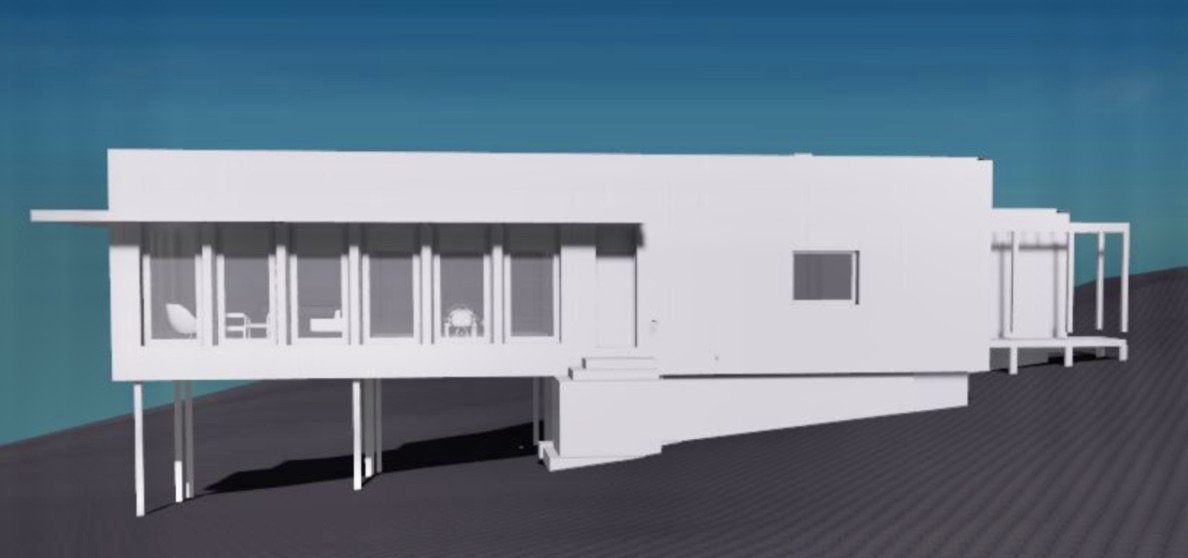Passive House and WELL Building Standard
Our new house will use a fraction of the energy used to heat and cool a traditional house. It will conserve resources and thus be sustainable. Other aspects of the house that qualify it as sustainable will be the materials, which, with the exception of the windows will come from local sources. The house exterior will be finished with a mixture of pine tar and linseed oil, a non-toxic and maintenance free application method used extensively in Scandinavian countries. The features of fresh air 24/7 and prevention of toxic particulate matter described above have been a huge aha moment for me. These features dovetail with a new area of research, the WELL Building Standard, for which I just received accreditation.
Our house framed: exterior walls are two feet thick for insulation.
Major aspects of the sustainability criteria we used quite fortuitously will promote our health and well-being:
The ideas to do this are as follows:
Fresh air: The Energy Recovery Ventilation system we are using to heat and cool will circulate fresh air throughout the house 24/7
Optimal sunlight exposure: the house will engage the landscape with operable floor to ceiling windows on its south orientation
No toxic hydrocarbons: the absence of carbon producing elements, gas stoves and fireplaces, will keep the air free of toxic particulate matter
Moisture control: with superior insulation and waterproofing the house will inhibit the growth of other toxins such as mold
The features of fresh air 24/7 and prevention of toxic particulate matter described above have been a huge aha moment for me. These features dovetail with a new area of research, the WELL Building Standard, for which I just received accreditation.
WELL is a new standard that addresses people, their health and their comfort
The WELL Building Standard was developed to complement sustainability programs such as LEED (leadership in Energy and Environmental Design). While sustainability programs like LEED rate buildings or communities that have been put in place, WELL is focused on the people that inhabit the spaces. There are presently 2,160 projects encompassing over 385 million SF applying WELL standards across 51 countries.
WELL is made up of 7 categories
Air
Water
Nourishment
Light
Fitness
Comfort
Mind
Let’s visit the first category of air. Poor quality air has been associated with physical illness and cognitive impairment. 50,000 deaths a year in the United States are attributed to poor air quality. The California Air Resources Board (CARB) has identified about 200 pollutants in air as toxic. WELL encourages clients to test air quality on a regular basis to control and eliminate these contaminants, including:
Carbon monoxide
Volatile organic compound (VOC) particles
Particulate matter 10 (includes mold)
Particulate matter 2.5 (microscopic organic toxins that can be inhaled)
In passive house design, these guidelines for ensuring clean air are followed and, in many cases, improved upon
Because we will use a heating and cooling system that uses only fresh air (unlike typical systems which mix exhaust air with fresh) the air quality will be of far better quality and will meet or exceed standards set up by The American Society of Heating, Refrigerating and Air-Conditioning Engineers (ASHRAE) ventilation and energy standards.
We will have fresh air circulating 24 hours, 7 days a week. Most heating and cooling systems stop and restart depending on how the temperature and humidity are.
elimination of items that produce toxic particulate matter (fireplaces and gas cook tops for instance our house will have floor to ceiling operable windows that are triple. glazed.
The house is now in construction, and when completed will almost heat and cool itself. The energy recovery ventilation, insulation, and 4’ wide floor to ceiling operable windows all combine to save energy and ensure clean air.
Air pollution is a huge global problem and laws need to be in place to control contaminants as described above. Our healthy house won’t provide immunity from this problem, but it’s a start. and it may, by example, help other homeowners understand the issues and build their homes with some of these concepts in mind.
Major aspects of the sustainability criteria we used quite fortuitously will promote our health and well-being:
The ideas to do this are as follows:
Fresh air: The Energy Recovery Ventilation system we are using to heat and cool will circulate fresh air throughout the house 24/7
Optimal sunlight exposure: the house will engage the landscape with operable floor to ceiling windows on its south orientation
No toxic hydrocarbons: the absence of carbon producing elements, gas stoves and fireplaces, will keep the air free of toxic particulate matter
Moisture control: with superior insulation and waterproofing the house will inhibit the growth of other toxins such as mold





